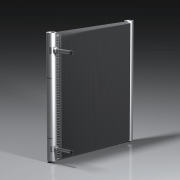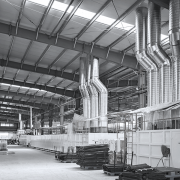Helium leak test explained
As energy efficiency and environmental regulations tighten across the HVAC industry, leak testing has become more important than ever. With the growing shift to climate-friendly refrigerants and the adoption of compact, high-efficiency components, ensuring leak-tight systems is not only critical but also increasingly challenging.
Traditional methods like water bath or soap bubble testing are quickly becoming outdated. They simply can’t provide the precision needed for modern heat exchangers. In contrast, helium leak detection, especially in vacuum conditions, has emerged as the gold standard—offering unmatched sensitivity, speed, and consistency.
Vacuum Method: The Optimal Solution for Microchannel Coil Testing
Among modern leak detection techniques, the vacuum method stands out as the most accurate and reliable—particularly for mass production of microchannel coils.
Here’s how it works: the part is placed inside a vacuum chamber, sealed, and the air is removed. Helium is then introduced into the coil, and a highly sensitive sensor (a helium mass spectrometer) checks whether any helium escapes into the vacuum chamber. If it does, it’s a sign of a leak.
While setting up this type of system requires advanced equipment and comes at a higher initial cost, the benefits are clear:
- Extremely high sensitivity, capable of detecting even microscopic leaks
- Fast cycle times, ideal for high-volume, automated production
- Full-part testing, verifying the entire coil in one step
- Lower helium usage, often reduced to around 1%, minimizing tracer gas costs
This method ensures each coil meets the most stringent quality standards, especially important for products used in high-performance HVAC and refrigeration systems.
Why Helium?
Helium is the preferred tracer gas for a simple reason: it works better than anything else. As a chemically inert noble gas, it’s completely safe, non-flammable, and non-toxic. Its very small atomic size lets it pass through the tiniest leaks, and its low natural presence in the atmosphere (only about 5 parts per million) makes any helium detected during testing easy to trace and quantify.
These characteristics make helium perfect for high-precision leak testing where accuracy and reliability are critical.
Uncompromising Leak Integrity at Kaltra
At Kaltra, every microchannel coil undergoes helium leak testing using the vacuum method, with a market-leading leak rate threshold of just 2 grams per year. This ultra-low limit guarantees:
- Long-term airtightness
- Maximum system efficiency
- Minimal refrigerant loss over the product’s lifetime
100% of our coils are tested, and for units that receive additional treatments—like anti-corrosion epoxy or nano coatings—a second leak test is performed to ensure continued sealing performance after processing.
Understanding Leak Rate and Gas Flow
In real-world applications, no system is entirely leak-proof—but it doesn’t need to be. What matters is that the leak rate remains low enough to prevent performance losses or refrigerant escape.
Think of leak rate as a measure of how much gas escapes over time. The lower the rate, the better the seal—and the more reliable the product. Since different gases behave differently, using a sensitive and consistent tracer like helium allows for extremely accurate detection.
In components like microchannel coils, where tolerances are extremely tight and design complexity is high, even a tiny leak can cause big problems. That’s why only high-precision machinery and detection systems—such as vacuum chambers, calibrated flow controls, and helium mass spectrometers—can deliver the consistency and accuracy needed in modern coil manufacturing.








